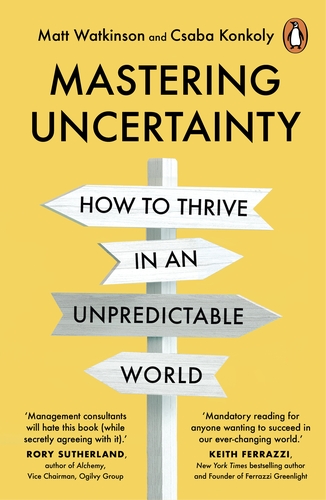
Where we read business books so you don’t have to! In an age marked by instability, the ability to navigate uncertainty has become a non-negotiable skill for leaders. This month we read Mastering Uncertainty by Matt Watkinson and Csaba Konkoly, to highlight what leaders can do to increase their chances of success in changeable times.
In their chapter on Creating Your Own Luck they discuss that while yes, successful leaders can get lucky, it’s individuals that strive to create their own good fortune and keep their heads when dealt a bad hand that end up being successful. As Wayne Gretzky says, “You miss 100% of the shots you don’t take.” Watkinson and Konkoly detail five mindset principles that help to create this good fortune:
- Develop a growth mindset
- Develop a healthy relationship with failure
- Be tenacious
- Seek the truth
- Pursue mastery not perfection
1. Develop a growth mindset
A growth mindset is the belief that our abilities can change and grow with continuous effort and guidance from others. The alternative is a fixed mindset, where we believe our qualities are immutably set in stone. In the latter scenario, individuals focus on proving rather than improving their abilities. A fixed mindset and fear of failure go hand in hand and keep us in our comfort zone, which is not where you want to sit in an uncertain world, where you need to constantly learn and change tack.
Leaders should question how they can maintain a growth mindset as they develop in their career. What do you do to stay coachable? Would others say your ego impacts your decision making?
Be proactive in developing this. Find experts, surround yourself with them, and ask them questions about what they do and then seek to put it into practice. There are no medals for finding your way on your own – when things change, find someone who has walked this path before. Truly question if you are really asking for and getting constructive criticism – if no one around you has given you feedback that is slightly uncomfortable, chances are they aren’t able to and the impact on that is that you’re not moving forwards. A good example of this is when Satya Nadella, CEO of Microsoft, adopted a Growth Mindset and has since stated that much of their success is due to this cultural change – the learn-it-all does it better than the know-it-all.
2. Develop a healthy relationship with failure
Companies that don’t take chances are unable to pivot when needed, and to take chances, they need a heathy relationship with failure. That doesn’t mean accepting poor results, it means that fear of failure doesn’t prevent them from taking opportunities.
This is largely about company culture. Are people judged harshly for things that don’t work, or do people push for success but accept that not everything has to be successful to continue to grow and thrive? Some ways to reset how your team think about failure include:
- Remind people that the opposite of success is not failure, it’s learning. We only learn through iteration and experimentation.
- Share success stories where people have shown courage and focussed on trying new things
- Understand when failure is a success. For example stepping away from an acquisition because it’s not quite right, a product being sunsetted as other products have now overtaken it… these things can feel like a failure, but they don’t need to be framed that way. They are steps on the path to success.
3. Be tenacious
The book highlights that the biggest difference between those who succeed and those who don’t is whether or not they give up. While successful CEOs are cognisant of when something isn’t working, they also back themselves and persevere if they believe in projects.
Tenacity doesn’t mean pursuing one goal at all costs, it usually means learning, adjusting and then making progress. It is ensuring that setbacks such as operating on a changed playing field, don’t cause you to give up. It took James Dyson 5,127 prototypes before his bagless vacuum cleaner worked, and then every distributor rejected his idea, leading him to found his own company. The whole process took 15 years, but he recognised that his fundamental idea was one he still believed in and kept pursuing.
4. Seek the truth
In business, and in life, clarity comes from sifting the truths from the untruths, and it helps us to recalibrate when we’re in an uncertain environment. To achieve this it’s important for CEOs to adopt active open-mindedness, so that they are happy to seek out new ideas, as well as new people who provide a diverse array of perspectives. By having this range of perspectives it is easier to filter what is real and pragmatic, rather than having a narrowminded view of the horizon. Surround yourself by people who have different skills and behaviours to you, rather than those who will support or replicate your own outlook.
5. Pursue mastery not perfection
A desire to keep improving is a good thing, but perfection can be the enemy of progress, and when things change quickly it can very quickly put you behind. Perfectionism is often driven by fear and anxiety; you see this when tech teams keep tweaking their product rather than putting it into the market. Instead, it is more important to focus on mastery – in that scenario you launch, learn and improve. The book highlights the three phases individuals go through to reach this stage:
- Apprenticeship: learn the basics of your craft through focus, practice and observation
- Creatively active: apply your own ideas adding life experiences and personality into the mix
- Mastery: you have deeply internalised the skills of your craft. Your intuition has become a powerful tool and allows you to connect dots others can’t see
In this scenario, the activity you’re pursuing then becomes the reward in itself and leads to a virtuous cycle of continuous improvement.

